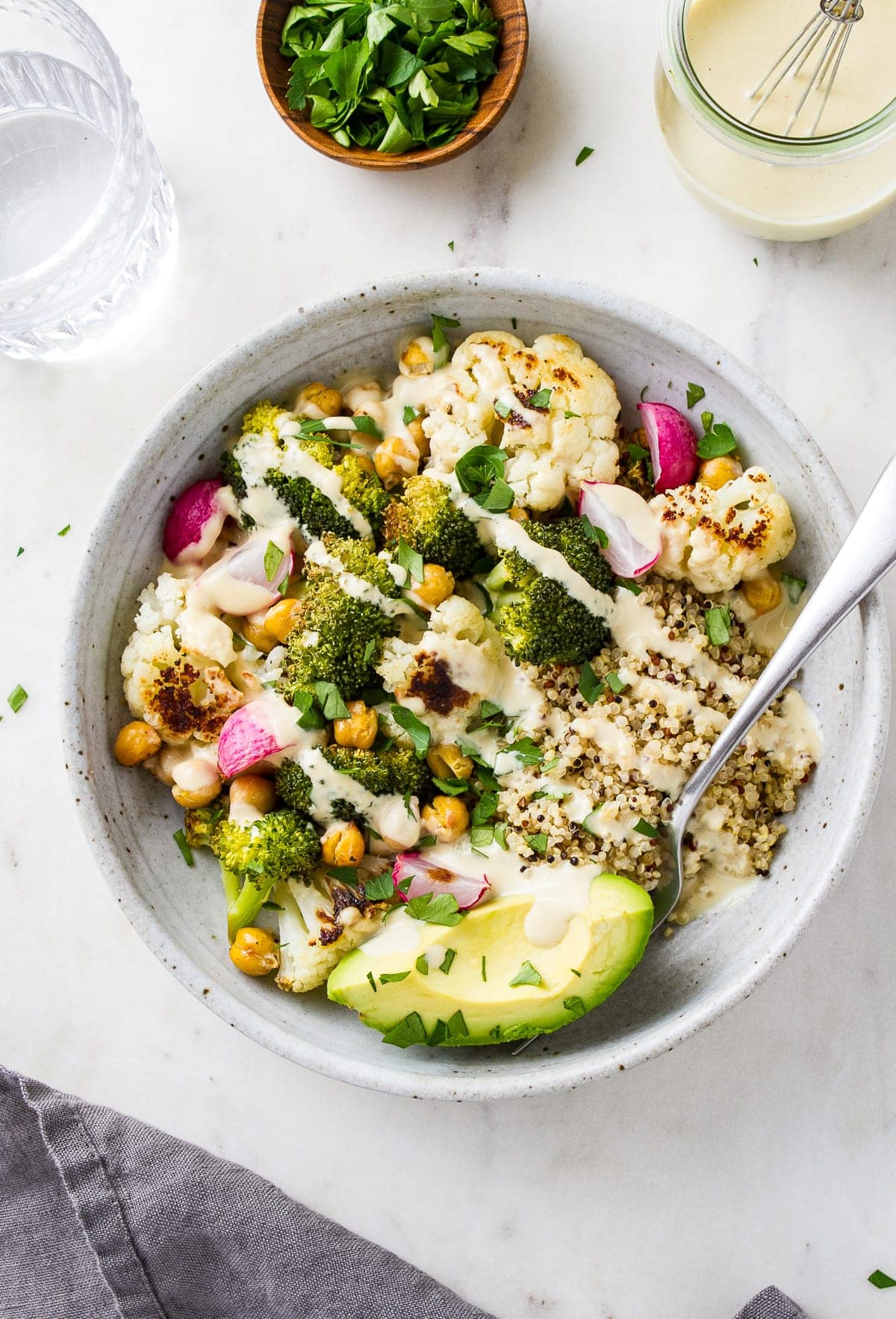On this website, some posts contain affiliate links, which means that if you buy a product using my link, I may earn a commission.
Buddha bowls with roasted vegetables, quinoa, and hummus are a healthy and versatile meal packed with nutrients and flavors. Combining a variety of plant-based ingredients, these bowls provide a balanced combination of carbohydrates, proteins, and vegetables, making them a satisfying and nutritious choice.
Whether you’re a vegan, vegetarian, or simply looking to incorporate more plant-based meals into your diet, Buddha bowls are a delicious and easy option for any meal of the day. With the roasted vegetables adding a hint of sweetness and the quinoa providing a satisfying grain base, topped with a dollop of creamy hummus, these bowls are not only visually appealing but also a treat for your taste buds.
Explore different combinations of veggies, grains, and dressings to create your own unique version of this popular dish.
Heading 1.1: Why Buddha Bowls Are The Perfect Healthy Meal Option
Buddha bowls are the perfect healthy meal option for several reasons. First of all, they are easy to prepare, making them a convenient choice for busy individuals. By simply roasting vegetables and cooking quinoa, you can create a satisfying bowl in no time.
Moreover, the ingredients used in buddha bowls are versatile. You can customize your bowl according to your taste and dietary preferences. From leafy greens to colorful veggies, the possibilities are endless. Add a scoop of hummus for creaminess and flavor, and you have a hearty, delicious meal.
Lastly, buddha bowls offer a balanced nutrition profile. With a combination of whole grains, plant-based proteins, and fiber-rich vegetables, they provide essential nutrients to fuel your body and keep you feeling full and energized.
| Benefits of Buddha Bowls |
|---|
| Easy to prepare |
| Versatile ingredients |
| Balanced nutrition |
Heading 1.2: Exploring The Benefits Of Roasted Vegetables
Discover the advantages of enjoying Buddha bowls filled with mouthwatering roasted vegetables, nutritious quinoa, and delicious hummus. This wholesome combination will leave you feeling satisfied and energized.
Buddha bowls are a wholesome and nutritious meal option that includes a combination of grains, roasted vegetables, and flavorful toppings. The star ingredient in these bowls is the roasted vegetables. By roasting the vegetables, their flavors are enhanced, creating a delicious and satisfying experience for your taste buds. Additionally, roasting vegetables helps to retain their nutrients, making it a healthy cooking option. You can use a variety of vegetables such as sweet potatoes, Brussels sprouts, and bell peppers, depending on your preference. Roasting also offers versatility, as you can experiment with different seasonings and spices to create unique flavor profiles. Whether you prefer a savory or spicy taste, roasted vegetables can be customized to suit your palate. Adding quinoa and hummus to the bowl provides a good balance of carbohydrates and protein, making it a well-rounded meal. So why not try a Buddha bowl with roasted vegetables, quinoa, and hummus for a nutritious and satisfying dish?Heading 1.3: The Nutritional Powerhouse: Quinoa
Buddha bowls with roasted vegetables, quinoa, and hummus are not only delicious but also a nutritional powerhouse. Quinoa is known for its high content of protein and fiber, making it a great addition to any meal. It is also packed with essential vitamins and minerals such as iron, magnesium, and phosphorus. Moreover, quinoa is gluten-free and suitable for various dietary needs, including those who follow a vegetarian or vegan lifestyle.
Heading 1.4: The Delightful Creaminess Of Hummus
Buddha bowls are a popular choice for healthy, nutritious meals. One of the delightful ingredients that adds creaminess and flavor to these bowls is hummus. Hummus is not only tasty, but it also has several health benefits. It is nutrient-rich and low in calories, making it a great addition to a balanced diet. What sets hummus apart is its high plant-based protein content, making it an excellent option for vegetarians and vegans. Moreover, hummus offers versatility when it comes to flavors. There are various delicious varieties available, such as garlic, roasted red pepper, or even spicy versions. This allows you to customize your Buddha bowl and tailor the flavors to your liking. Whether you’re looking to add a creamy texture or a burst of flavor, hummus is a fantastic choice for your Buddha bowl!
Heading 2.1: Selecting The Right Vegetables For Roasting
Seasonal options are the key to creating delicious Buddha bowls with roasted vegetables. By using vegetables that are in season, you ensure the freshest flavors and maximize nutritional benefits. Some popular options for roasting include bell peppers, sweet potatoes, broccoli, cauliflower, and Brussels sprouts.
Balancing colors and textures is another important aspect of creating a visually appealing and satisfying Buddha bowl. Opt for a mix of colorful vegetables like red, yellow, and green bell peppers, along with vibrant orange sweet potatoes. This not only adds visual interest but also provides a variety of flavors.
When it comes to flavors that complement each other, think about pairing sweet and savory elements. For example, roasted sweet potatoes go well with tangy tahini dressing, while roasted Brussels sprouts pair nicely with a zesty lemon vinaigrette. Experiment with different combinations to find your favorite flavor profiles.


Credit: simple-veganista.com
Heading 2.2: Mastering The Art Of Perfectly Roasted Vegetables
- Wash and chop the vegetables into bite-sized pieces.
- Ensure that the vegetables are dry before roasting.
- Toss the vegetables with olive oil, salt, and pepper for a basic seasoning.
- Experiment with different seasonings like garlic powder, paprika, or cumin, based on your taste preferences.
- Marinating the vegetables in the seasoning mixture for 15-30 minutes can enhance the flavor.
| Vegetable | Cooking Temperature | Cooking Time |
|---|---|---|
| Bell Peppers | 425°F (220°C) | 15-20 minutes |
| Broccoli | 400°F (200°C) | 15-20 minutes |
| Sweet Potatoes | 425°F (220°C) | 20-25 minutes |
To achieve the perfect roasted vegetables for your Buddha bowl, follow these guidelines for preparation, seasoning, and cooking. Enjoy a healthy and flavorful meal!
Heading 2.3: Cooking Quinoa To Perfection
To cook quinoa to perfection, it is important to follow proper rinsing techniques. Start by rinsing the quinoa under cold water using a fine mesh strainer to remove any bitter saponins. Rub the quinoa gently with your fingers while rinsing to ensure thorough cleaning.
Once rinsed, use a water-to-quinoa ratio of 2:1 for fluffy quinoa. Add two cups of water for every cup of quinoa in a pot and bring it to a boil. After it reaches boiling point, reduce the heat to low and cover the pot with a lid. Allow the quinoa to simmer for approximately 15 minutes or until all the water has been absorbed.
After simmering, remove the pot from the heat and let the quinoa rest, still covered, for about 5 minutes. This resting time allows the quinoa to fully absorb the moisture and become light and fluffy. Fluff the quinoa with a fork before serving to separate the grains.
By following these steps, you can achieve perfectly cooked quinoa that will complement your Buddha bowls with roasted vegetables and hummus.
Heading 2.4: Elevating The Hummus Experience
Elevate your Buddha bowl experience with a flavorful homemade hummus recipe. Experimenting with flavors and ingredients can take your hummus to a whole new level. By adding roasted garlic, roasted red pepper, or even a touch of spice, you can customize your hummus to suit your taste buds. Not only does this elevate the taste, but it also enhances the presentation of your Buddha bowl.
Garnishing your hummus with a drizzle of olive oil, a sprinkle of paprika, or a handful of fresh herbs can add visual appeal to your dish. Think beyond the traditional chickpeas and tahini and let your creativity shine. With just a few simple additions and some creative garnishes, you can take your Buddha bowl experience to the next level.
Heading 3.1: Building The Perfect Buddha Bowl
| Building the Perfect Buddha Bowl |
In this blog post, we will explore how to build the perfect Buddha bowl. Creating a visually appealing bowl is the key, as it entices you to discover the delicious ingredients inside. Layering the ingredients is an important step in achieving an aesthetically pleasing bowl. Start with a base of quinoa – a protein-packed grain that adds a satisfying texture and nutty flavor.
Next, roasted vegetables are added for both taste and color. Choose a variety of vegetables like sweet potatoes, rainbow carrots, and Brussels sprouts.
To complete the bowl, a dollop of creamy hummus is added. This adds a burst of flavor and also acts as a dressing. Mixing complementary flavors and textures is crucial to creating a satisfying meal. Consider adding crunchy elements like toasted nuts or seeds, and a burst of freshness with some tangy pickled vegetables or a handful of fresh herbs like cilantro or mint.
So go ahead, get creative with your Buddha bowl and enjoy a nutritious and delicious meal that is as beautiful as it is tasty!
Heading 3.2: Adding An Extra Boost With Toppings And Dressings
Buddha bowls are a great way to incorporate a variety of nutritious ingredients into one delicious meal. Adding nut and seed toppings can provide an extra boost of flavor and texture. Some popular options include toasted sesame seeds, crushed almonds, and pumpkin seeds. These toppings not only add a crunchy element to your bowl, but they also offer a dose of healthy fats and protein.
When it comes to dressings, there are endless possibilities to complement your Buddha bowl. You can whip up a tangy lemon tahini dressing or opt for a creamy avocado cilantro dressing. Balancing acidity and creaminess is the key to a well-rounded dressing. A popular recipe is a simple combination of olive oil, apple cider vinegar, Dijon mustard, and maple syrup.
Experimenting with different toppings and dressings is all part of the fun when it comes to Buddha bowls. These customizable bowls not only provide a visually appealing presentation but also offer a nutritional powerhouse in one delicious dish.
Heading 3.3: Serving And Enjoying Your Buddha Bowl
You’ve chosen a delicious and nutritious combination for your Buddha Bowl with roasted vegetables, quinoa, and hummus. Now let’s talk about serving and enjoying your creation:
| Ingredient | Portion Size |
|---|---|
| Roasted vegetables | 1 cup |
| Quinoa | 1/2 cup |
| Hummus | 2 tablespoons |
- Start by adding a bed of quinoa as a base for your bowl.
- Next, arrange the roasted vegetables on top of the quinoa.
- Spoon dollops of hummus around the bowl.
- Feel free to add any additional garnishes or toppings of your choice.
- Finally, gently mix everything together, ensuring that every bite contains a balance of flavors.
When you take your first bite, pay attention to the combination of flavors and textures. The roasted vegetables should provide a satisfying crunch while the quinoa offers a hearty and nutty taste. The smooth and creamy hummus ties everything together with its rich and zesty notes. Enjoy every mouthful, savoring the harmony of tastes and the nourishing benefits of this revitalizing Buddha Bowl.
Frequently Asked Questions For Buddha Bowls With Roasted Vegetables, Quinoa, And Hummus
What Vegetables Are Commonly Used In Buddha Bowls?
Buddha bowls commonly include a variety of roasted vegetables, such as broccoli, cauliflower, sweet potatoes, and bell peppers. These vegetables provide a delicious and nutritious base for the bowl, packed with vitamins, minerals, and fiber.
Why Is Quinoa A Popular Choice For Buddha Bowls?
Quinoa is a popular choice for Buddha bowls because it is a complete protein, meaning it contains all nine essential amino acids. It is also gluten-free and rich in fiber, making it a nutritious and filling addition to the bowl.
Why Is Hummus A Common Dressing For Buddha Bowls?
Hummus is a common dressing for Buddha bowls because it adds a creamy and tangy flavor, while also providing a good source of protein and healthy fats. It pairs well with the roasted vegetables and quinoa, adding a delicious Mediterranean twist to the dish.
Conclusion
To sum up, Buddha bowls with roasted vegetables, quinoa, and hummus offer a delicious and nutritious combination that is easy to prepare and satisfying to eat. These bowls provide a balance of protein, fiber, and essential nutrients, making them a great choice for anyone seeking a wholesome and filling meal.
With endless possibilities for customization, you can create your own Buddha bowl masterpiece and enjoy a flavorful, plant-based dish that nourishes both your body and soul.
On this website, some posts contain affiliate links, which means that if you buy a product using my link, I may earn a commission.

